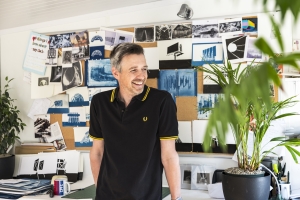Statement
Through drawing and printmaking Ian Chamberlain reinterprets man-made structures as monuments in the landscape. These structures are architectural metaphors of past and current technological achievements. He has had a long-standing fascination with technology and architectural forms especially the structures within industry, agriculture, science and the military. These have included Goonhilly Earth station, The Lovell Telescope, Cheshire Maunsell Sea Forts in the Thames estuary and the Acoustic Sound Mirrors on the South Kent Coast.
Chamberlain uses traditional process and materials including etching and pencil to record structures. He articulates the textures and surface details within the rich surfaces of his images by building complex layers of mark and tone. The structures he draws are often now derelict or partially demolished. The etchings become an extension of his drawing, allowing him to record the location through the interlinking processes of Drawing and print.
This notion of preservation and conservation has Chamberlain to consider the work as a graphic historical record. By recording these structures he has started to highlight their historical, cultural and social impact documenting the architectural remains of human activity.
The notion of time passing greatly influences the structures Chamberlain records and also plays an important role in the decisions he makes when making work through particular processes – drawing in pencil, etching or photography – all are able to evoke time within the final image in different ways and at different speeds.
The passing of time also influences what is remembered about the places visited, it becomes a fine balance in the work, between the spontaneity and immediacy of the original drawn marks and sketches and the lengthier more considered methodical approach of the printmaking process.
These figurative representational references have been further informed by literary sources, including Ozymandias by Percy Shelley, Invisible Cities by Italo Calvino and Terminal Beach by J.G Ballard.
Ian Chamberlain’ s prints and drawings are held in the collections of the Victoria and Albert Museum, London; Tate Modern, London; Bristol Museum; Royal West of England Academy, Bristol; Pallant House Gallery, Chichester; The University of Chichester collection; The Ashmolean, Oxford Chippenham Museum and The Victoria Gallery, Bath, UK.
Ian Chamberlain lives and works in Bristol, UK. In addition to his studio practice he is also a Senior Lecturer in M.A Multi-Disciplinary at (UWE) The University of the West of England, Bristol, UK.
